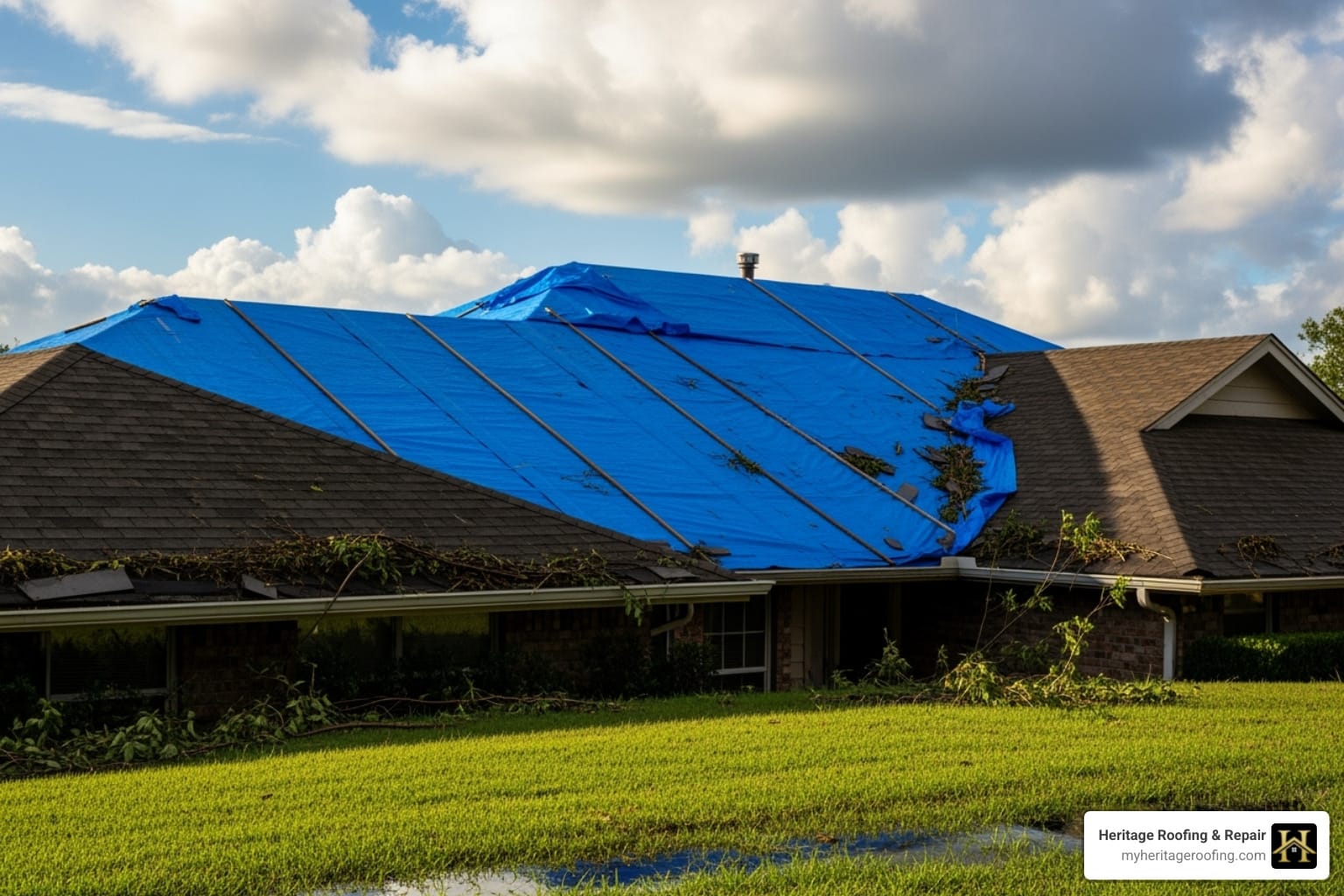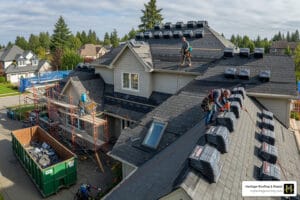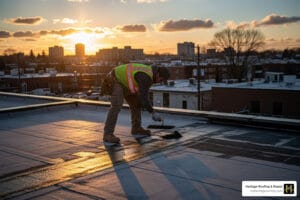Why a Leaky Roof Can’t Wait: Understanding Emergency Tarping
When a storm damages your roof, immediate action is crucial. Emergency roof tarping is a critical temporary measure that protects your home from water intrusion and further damage until permanent repairs can be made. For homeowners in Arkansas, understanding when and how to act can mean the difference between a minor inconvenience and a major disaster. At Heritage Roofing & Repair, we’ve seen how a quick response can save thousands in costly repairs. This guide will walk you through everything you need to know about emergency roof tarping, from identifying the need to understanding the process and navigating insurance claims.
If you suspect your roof is compromised, securing prompt emergency roof repair services is the most important step you can take to safeguard your home and family.
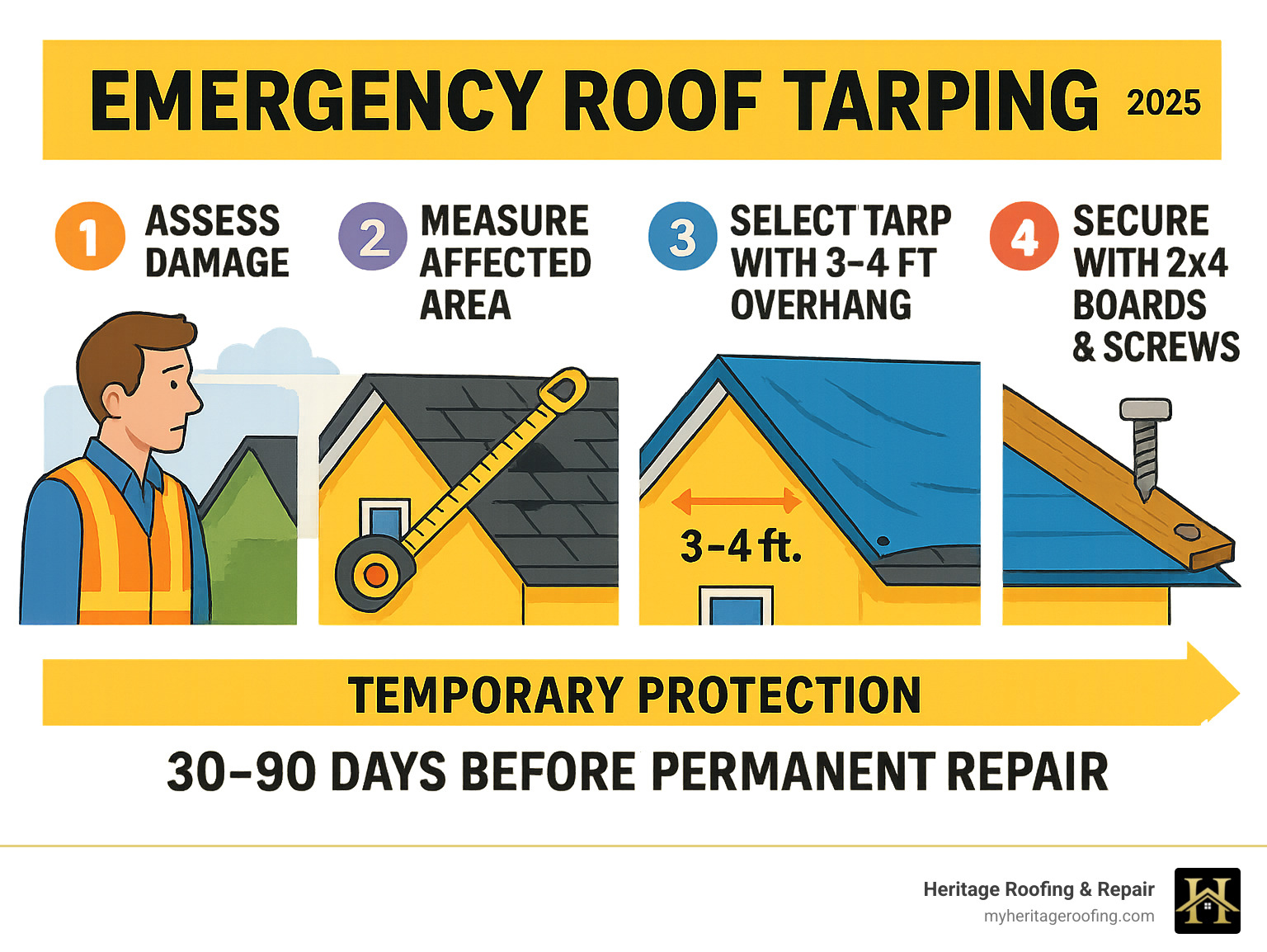
The potential risks of not tarping a damaged roof are significant. Without a protective cover, your home is exposed to the elements, leading to water intrusion that can damage ceilings, walls, and personal belongings. This moisture creates a breeding ground for mold and mildew, which can cause serious health issues and further degrade building materials. Unchecked water damage can also compromise insulation, leading to higher energy bills, and in severe cases, weaken the structural integrity of your home.
When to Act: 7 Signs Your Roof Needs Immediate Tarping
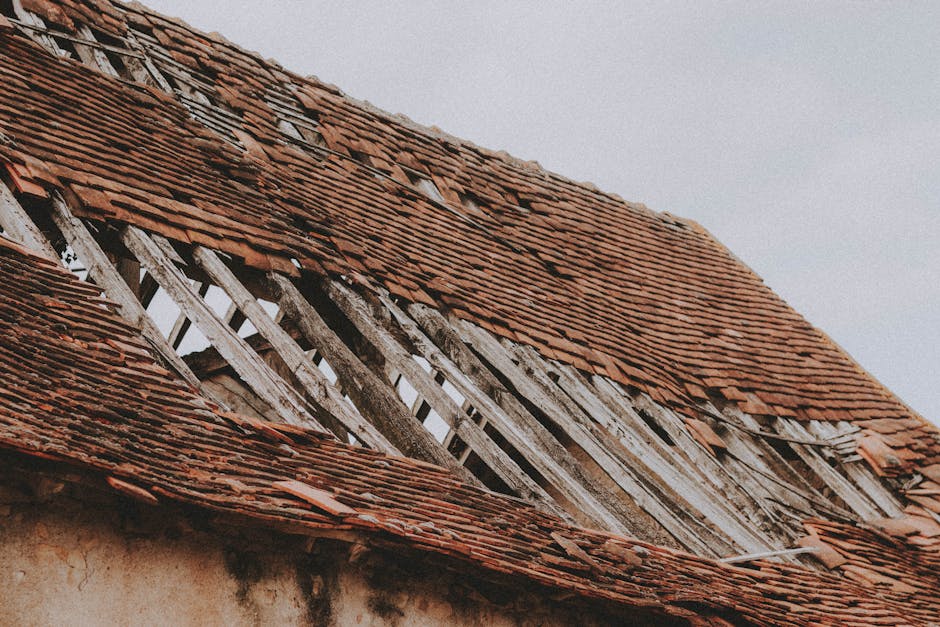
Recognizing the warning signs of roof failure is crucial. Delay can lead to thousands in damages that could have been prevented. If you notice any of the following, it’s time to consider emergency roof tarping:
- Obvious Storm Damage: This is the most apparent sign. If you see missing or broken shingles on your lawn, large dents from hail, or notice that wind has lifted sections of your roof, immediate action is needed.
- Visible Holes or Punctures: A tree limb or flying debris can create a direct opening to the outside, which is a clear pathway for water.
- Daylight Showing Through the Attic: If you can see light filtering through the roof from your attic, it means there are openings that will let in rain.
- Active Water Leaks: If you see water dripping from your ceiling or notice new water stains on walls, your roof is actively failing. The sound of dripping water after a storm is a major red flag.
- Sagging Roof Deck: A sagging roof, particularly after heavy rain or snow, can indicate underlying structural damage that requires immediate attention.
- Sudden Spike in Energy Bills: While less immediate, a sudden increase in your energy bills can be a subtle indicator of roof damage, as compromised insulation allows air to escape.
- Risks of Not Tarping: Beyond water damage, a compromised roof can lead to mold growth, pest infestations, and further structural decay, compounding repair costs.
Ignoring these signs is like leaving your front door open during a rainstorm. Prompt action is key to protecting your home.
The Homeowner’s Guide to DIY Emergency Roof Tarping
Sometimes, waiting for a professional isn’t an option, especially after a widespread storm. If you are comfortable with heights and have the right tools, you might consider performing emergency roof tarping yourself. This is a temporary fix and should only be done in safe conditions—never during a storm, in high winds, or on a wet roof.
Step 1: Safety, Assessment, and Measurement
Safety is paramount. Working on a damaged roof is dangerous. Always use a sturdy, properly secured ladder and have a spotter. Wear protective gear, including gloves and non-slip boots. If the roof feels unstable or you’re uncomfortable, stop and call a professional.
- Assess & Document: Inspect the damage from the ground first, using binoculars if needed. Take clear photos of all damaged areas for your insurance claim.
- Clear Debris: Carefully remove any branches or loose shingles with a broom. Avoid pressure washers, which can cause more damage.
- Measure: Measure the damaged area and add at least 4 feet to each side for overhang. If the damage is near the peak, ensure the tarp extends over it by at least 4 feet to allow for proper water runoff.
Step 2: Gathering Materials and Tools
Having the right materials ready will make the job safer and more efficient.
- Heavy-duty waterproof tarp (at least 10 mil thick)
- 2×4 wood planks (longer than the tarp’s width)
- 3-inch deck screws with galvanized washers
- Cap nails
- Essential Tools: Ladder, cordless drill, utility knife, hammer, safety gear.
Step 3: The Process of Emergency Roof Tarping
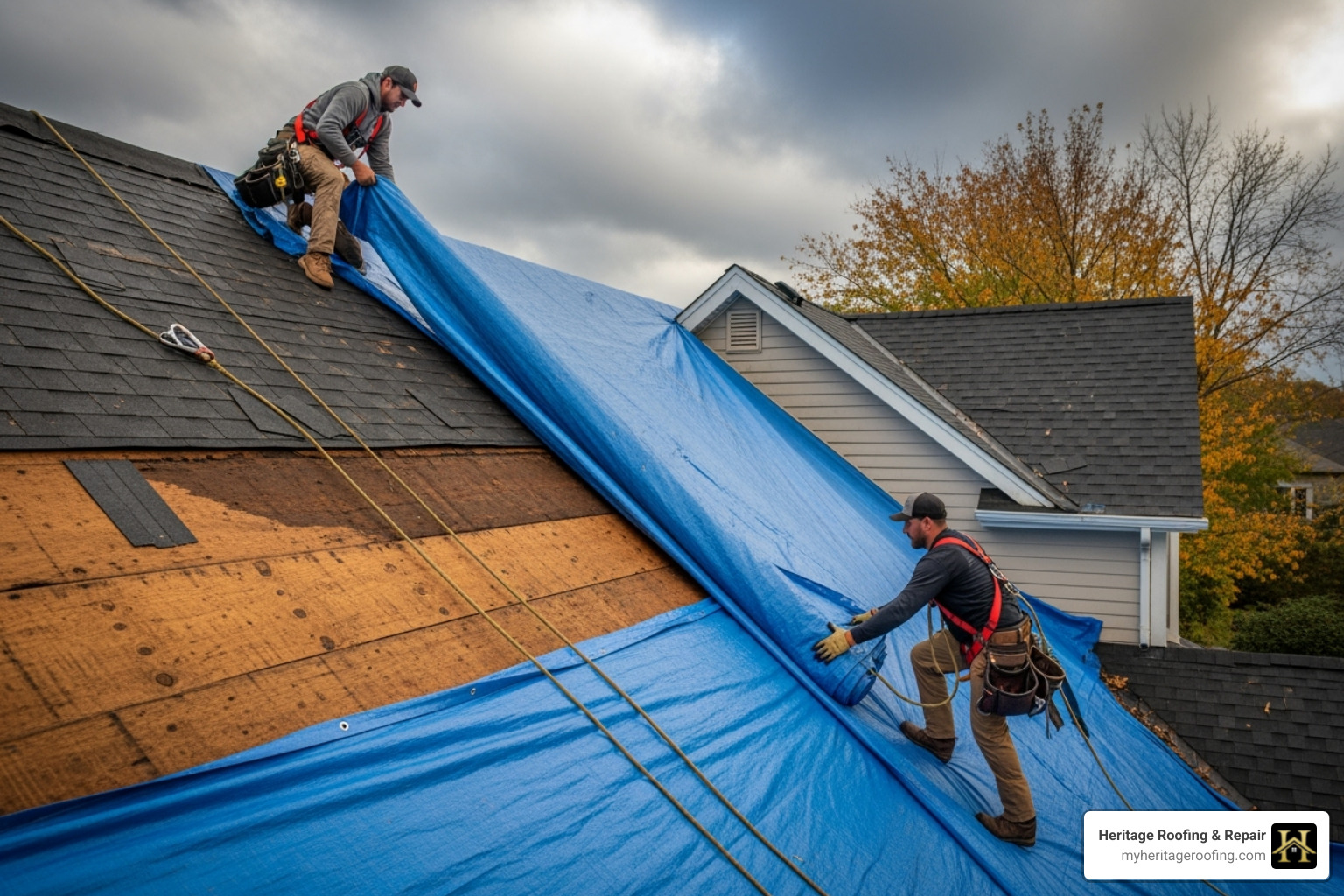
- Position the Tarp: With a helper, carefully unroll the tarp over the damaged area, ensuring it covers the roof’s peak if necessary.
- Anchor the Top: Roll the top edge of the tarp around a 2×4. Secure this board to the roof deck through the tarp using screws with washers every 8-12 inches. This “sandwich” method prevents tearing.
- Secure the Sides and Bottom: Pull the tarp taut. Roll the side and bottom edges around more 2x4s and secure them to the roof deck in the same manner. This creates a tight, wind-resistant seal.
- Handle Obstacles: For chimneys or vents, carefully cut an ‘X’ in the tarp, fold the flaps up against the obstacle, and seal them with high-quality roofing tape (like butyl tape) to create a watertight seal. Be careful not to block any vents.
For more visual guidance, you can refer to detailed instructions from home improvement experts.
DIY vs. Professional Tarping: A Cost and Risk Analysis
When your roof is damaged, you can either perform emergency roof tarping yourself or hire a professional. Each option has pros and cons regarding cost, safety, and effectiveness. For residents in Harrison, AR, and surrounding areas, weighing these factors is vital.
Here’s a quick comparison:
| Feature | DIY Tarping | Professional Tarping |
|---|---|---|
| Cost | $150-$350 (materials) | $400-$600+ (often covered by insurance) |
| Safety | High risk of injury | Low risk; professionals are trained & insured |
| Speed | Can be slow and difficult | Fast, efficient, and often 24/7 service |
| Effectiveness | Variable; risk of improper installation | Guaranteed to be watertight and secure |
| Insurance | Requires meticulous documentation | Professionals provide documentation for claims |
When to Call a Professional for Emergency Roof Tarping
If the roof is steep, the damage is extensive, or you’re uncomfortable with heights, calling a professional is the safest and most effective choice. A professional ensures the job is done right and provides the necessary documentation for your insurance claim.
At Heritage Roofing & Repair, we understand the urgency of a damaged roof. Our team is ready to provide prompt and reliable emergency roof tarping services throughout Northwest Arkansas.
- Heritage Roofing & Repair
- Address: 3458 Arkansas State Hwy 221, Berryville, AR 72616
- Phone: (870) 654-1164
For residents in Harrison, AR, and surrounding communities, our team is equipped to provide the rapid response you need. Learn more about our local services and how we can assist you by visiting our page for expert roofers in Harrison, AR.
After the Tarp: Insurance, Longevity, and Your Next Steps
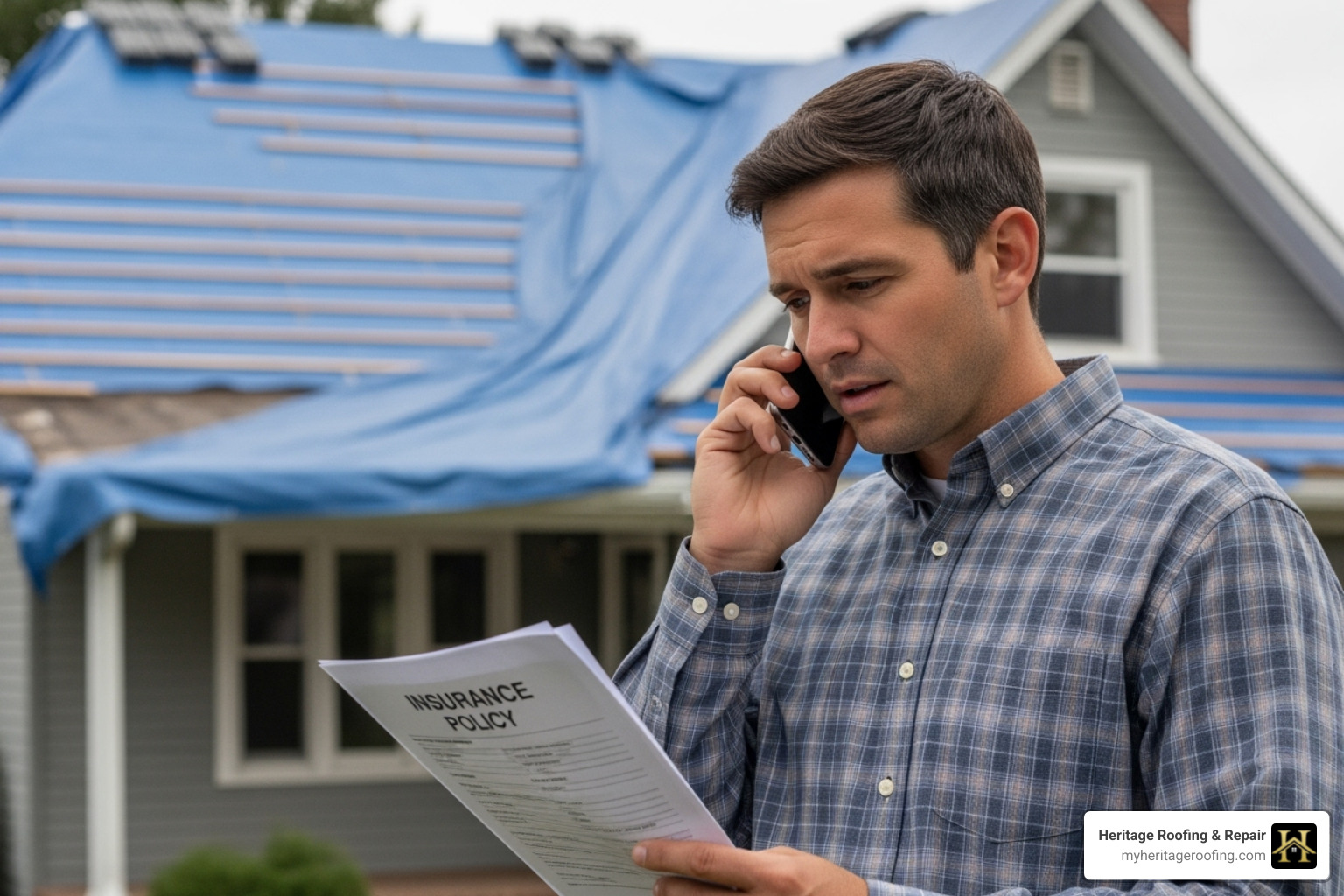
An emergency roof tarp is a temporary solution, not a permanent fix. Understanding its limitations and how it impacts your insurance claim is the final piece of the puzzle.
Tarp Lifespan and Risks of Leaving It Too Long:
- Temporary Nature: A high-quality, professionally installed tarp can last from 30 to 90 days, depending on weather conditions. However, it is not a long-term solution.
- Risks of Prolonged Use: Leaving a tarp on for too long can lead to new problems. UV rays degrade the material, wind can loosen it, and trapped moisture can cause mold and rot on the roof deck.
How Tarping Affects Insurance Claims:
- Mitigation of Damages: Most insurance policies require you to take reasonable steps to prevent further damage after a loss. Emergency roof tarping is a key part of this. Failing to do so could jeopardize your claim for any subsequent water damage.
- Coverage: Many policies cover the cost of temporary repairs, including professional tarping services. This is often considered part of the overall claim.
- Documentation is Key: To ensure your claim goes smoothly, take photos of the damage before tarping, keep all receipts for materials, and save the invoice from your professional roofer.
Understanding Estimates and Next Steps:
- Professional Inspection: The most important next step is to schedule a professional roof inspection. An expert can assess the full extent of the damage and provide a detailed estimate for permanent repairs.
- Plan for Permanent Repair: Based on the inspection, you can work with your contractor and insurance company to plan for a permanent solution, whether it’s a targeted repair or a full roof replacement.
Don’t Let a Damaged Roof Ruin Your Home
A damaged roof is a serious problem that requires immediate action. Emergency roof tarping is the essential first step to protect your home from further harm. Whether you choose a DIY approach for a minor issue or call in a professional for a safer, more secure solution, acting fast is what matters most. Once your home is protected, you can focus on the path to a permanent repair.
We understand the stress and urgency that comes with a compromised roof. With over 50 years of trusted experience in Northwest Arkansas, Heritage Roofing & Repair is dedicated to providing dependable, affordable, and quality craftsmanship, specializing in storm damage repair and insurance claims. If you need expert assistance with storm damage or navigating your insurance claim in the Harrison, AR area, don’t hesitate to contact our team for a free inspection and peace of mind. We’re here to help you save your roof and protect your home.
